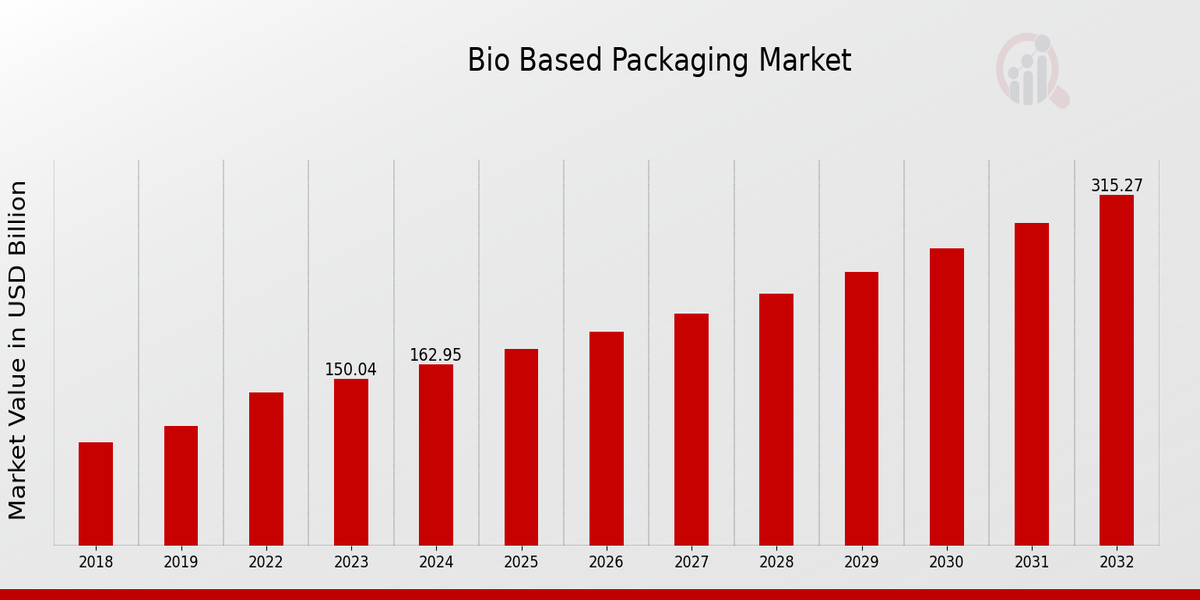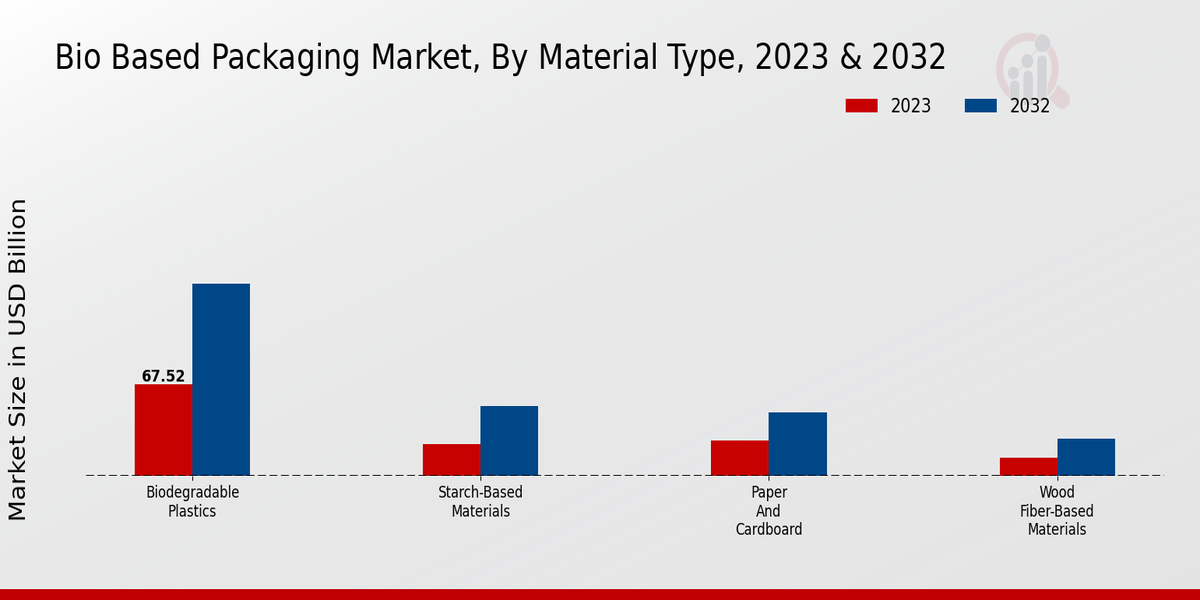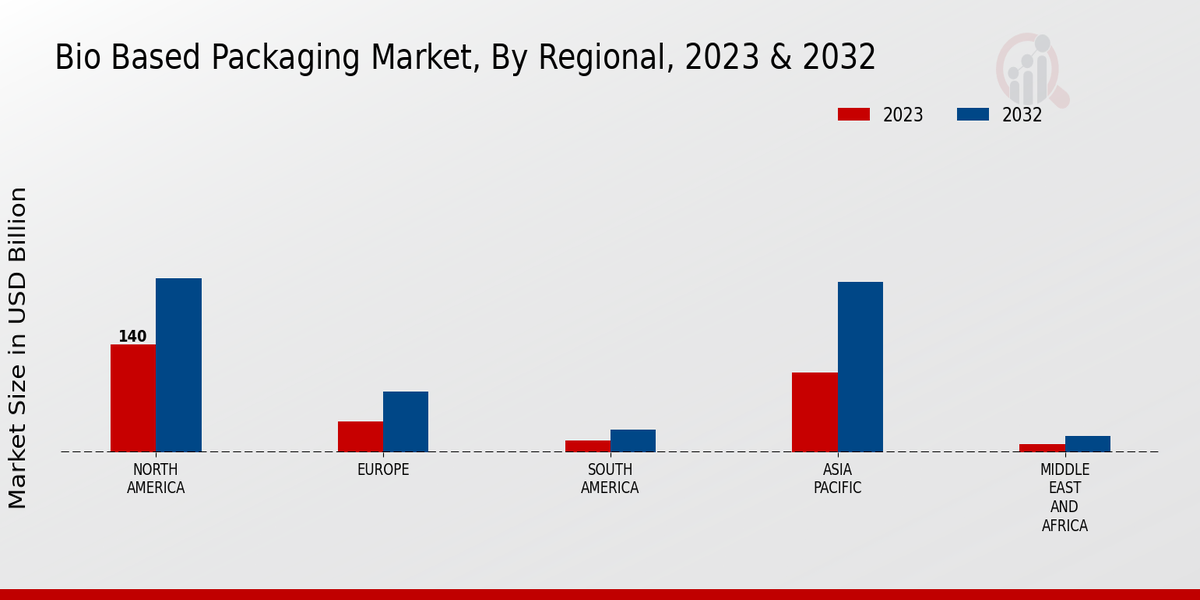Global Bio Based Packaging Market Overview:
The Bio Based Packaging Market Size was estimated at 177.06 (USD Billion) in 2024. The Bio Based Packaging Market Industry is expected to grow from 192.32 (USD Billion) in 2025 to 404.78 (USD Billion) by 2034. The Bio Based Packaging Market CAGR (growth rate) is expected to be around 8.60% during the forecast period (2025 - 2034).
Key Bio Based Packaging Market Trends Highlighted
The bio-based packaging market is experiencing significant growth, driven by rising consumer awareness of environmental sustainability and the need for eco-friendly packaging solutions. Regulatory mandates and industry initiatives aimed at reducing plastic waste are further propelling market expansion. Emerging technologies and advancements in bio-based materials research are opening up new avenues for innovation and product development.
Key trends shaping the market include the increasing adoption of compostable and biodegradable packaging, the use of renewable resources such as plant-based materials, and the integration of innovative packaging technologies to enhance functionality and reduce environmental impact. Opportunities lie in exploring biodegradable alternatives to traditional plastic packaging, developing sustainable and cost-effective bio-based materials, and leveraging advancements in printing and coating technologies to improve the aesthetics and functionality of bio-based packaging solutions.

Source: Primary Research, Secondary Research, MRFR Database and Analyst Review
Bio Based Packaging Market Drivers
Rising Consumer Demand for Sustainable Packaging Solutions
Changes in consumer behavior have a significant impact on the modern goods and services market. Thus, recently, customers have become more aware of the environmental impact of traditional packaging materials, raising the demand for more sustainable options. At the same time, bio-based packaging is typically made of renewable resources and is biodegradable and compostable. Therefore, consumer demand is the primary reason for the growth of the bio-based packaging market.However, this kind of packaging can provide benefits other than being sustainable. Thus, bio-based packaging may be lighter and more resilient than traditional packaging materials, which improves its convenience for use. It may also provide improved product protection. As consumers realize the benefits of using bio-based packaging, the demand is going to grow even further. Yet another factor facilitating rising consumer demand is government regulations.Thus, a range of countries are adopting regulations aimed at reducing the use of traditional packaging materials. In the EU, the so-called “packaging waste directive” is among the documents prompting an increase in bio-based packaging in the region. Overall, the increased consumer sustainability awareness and their consequent demand are primary factors in the growing display market. In the future, the demand is likely to increase even further as customers are getting more informed about the benefits of using bio-based packaging.
Technological Advancements in Bio-based Packaging Materials
Among the major growth drivers of the bio-based packaging market, is the fact that the development of new and innovative bio-based packaging materials is taking place. In the past few years, the bio-based packaging industry has witnessed several important technological advancements that have led to the development of a new generation of bio-based materials that are more cost-effective, durable, and versatile than traditional packaging materials.The most important technological advancements in the bio-based packaging industry refer to the development of new bio-based polymers. Essentially, bio-based polymers are derived from renewable resources such as plant-based materials or recycled materials. Such materials offer several important advantages over traditional polymers, such as biodegradability, compostability, and the substantially reduced emission of greenhouse gasses. Apart from the development of new bio-based polymers, there have been other technological advancements in the bio-based packaging industry as well.For instance, researchers have discovered new ways to enhance the barrier properties of bio-based packaging materials. In addition, they came up with new techniques to make bio-based packaging materials more printable and improve their moisture and heat resistance. Thus, technological advancements are among the major drivers of the bio-based packaging market, which involves the development of more cost-effective bio-based packaging materials.
Growing Adoption of Bio-based Packaging by End-use Industries
Yet another major driver of the growth of the bio-based packaging market is the increasing adoption of bio-based packaging by end-use industries. Many end-use industries are now using bio-based packaging, including the food and beverage industry, the personal care industry, and the pharmaceutical industry. The food and beverage industry is one of the most important end-use industries for bio-based packaging. This is because bio-based packaging can be used to package a wide range of food and beverage products, including fresh produce, processed foods, and beverages.There are a number of reasons why the food and beverage industry is adopting bio-based packaging. For example, bio-based packaging can help to extend the shelf life of products, reduce food waste, and improve product safety. The personal care industry is also adopting bio-based packaging. This is because bio-based packaging can be used to package a wide range of personal care products, including cosmetics, toiletries, and fragrances. The pharmaceutical industry is another end-use industry that uses bio-based packaging.Bio-based packaging can be used to package a wide range of pharmaceutical products, including prescription drugs and over-the-counter medications. The adoption of these technologies by end-use industries is expected to continue in the coming years. As more and more end-use industries become aware of the benefits of bio-based packaging, demand for these materials is expected to continue to grow.
Bio Based Packaging Market Segment Insights:
Bio Based Packaging Market Material Type Insights
The Bio Based Packaging Market Segmentation by Material Type includes Biodegradable Plastics, Starch-Based Materials, Paper and Cardboard, and Wood Fiber-Based Materials. Among these, Biodegradable Plastics held the largest market share in 2023, accounting for approximately 45% of the revenue. The growth of this segment can be attributed to the increasing demand for sustainable and eco-friendly packaging solutions. Starch-Based Materials are expected to witness the fastest growth during the forecast period, owing to their biodegradability and cost-effectiveness.In 2023, the Bio Based Packaging Market revenue for Biodegradable Plastics was estimated to be around USD 67.52 billion, and it is projected to reach USD 142.29 billion by 2032, exhibiting a CAGR of 8.9% during the forecast period. The starch-Based Materials market is expected to grow from USD 23.45 billion in 2023 to USD 51.46 billion by 2032, at a CAGR of 9.2%. The paper and Cardboard segment is anticipated to reach USD 46.91 billion by 2032, growing at a CAGR of 8.5% from its 2023 value of USD 26.12 billion. Wood Fiber-Based Materials segment is projected to grow from USD 12.96 billion in 2023 to USD 27.49 billion by 2032, at a CAGR of 8.7%.The market growth for all segments is driven by factors such as rising environmental concerns, increasing demand for sustainable packaging, and government regulations promoting the adoption of bio-based materials. The growing awareness about the harmful effects of conventional plastics on the environment has led to a shift towards more eco-friendly alternatives, which is expected to continue driving the growth of the Bio Based Packaging Market.

Source: Primary Research, Secondary Research, MRFR Database and Analyst Review
Bio Based Packaging Market Application Insights
The Bio Based Packaging Market is segmented on the basis of its application, and it includes food and beverage packaging, personal care packaging, healthcare packaging, and industrial packaging. Among these segments, food and beverage packaging holds the largest share and is projected to grow at a CAGR of 8.2% during the forecast period (2024-2032). The growth of this segment is attributed to the increasing demand for sustainable packaging solutions in the food and beverage industry. Personal care packaging is another significant segment, and it is expected to grow at a CAGR of 8.7% during the forecast period.This growth is due to the rising demand for bio-based packaging solutions in the personal care industry, as consumers become more conscious about the environmental impact of their packaging choices. Healthcare packaging is also a growing segment, and it is expected to grow at a CAGR of 9.1% during the forecast period. This growth is attributed to the increasing demand for bio-based packaging solutions in the healthcare industry, as it helps to ensure the safety and integrity of medical products. Industrial packaging is the smallest segment, and it is expected to grow at a CAGR of 7.9% during the forecast period.This growth is attributed to the increasing demand for bio-based packaging solutions in the industrial sector, as it helps to protect products from damage during transportation and storage.
Bio Based Packaging Market End-User Insights
The end-user segment is a crucial aspect of the Bio Based Packaging Market segmentation. The major end-users of bio based packaging include the food industry, beverage industry, retail sector, and e-commerce industry. The food industry dominates the market, accounting for a substantial share of Bio Based Packaging Market revenue. The increasing demand for sustainable packaging solutions to reduce food waste and preserve product quality drives growth in this segment. The beverage industry is another significant end-user, with a growing consumer preference for eco-friendly packaging options.The retail sector is also witnessing increased adoption of bio based packaging as consumers become more environmentally conscious. The e-commerce industry presents significant growth opportunities for bio based packaging due to the rising demand for sustainable packaging for online deliveries. The Bio Based Packaging Market is expected to continue expanding, with end-user industries playing a pivotal role in driving market growth.
Bio Based Packaging Market Barrier Properties Insights
The Bio Based Packaging Market is segmented based on barrier properties such as oxygen barrier, moisture barrier, and grease barrier. Among these, the oxygen barrier segment held the largest market share in 2023 and is projected to continue its dominance throughout the forecast period. The growing demand for oxygen-sensitive products, such as food and beverages, pharmaceuticals, and electronics, is driving the growth of the oxygen barrier segment. Furthermore, the increasing adoption of bio-based packaging solutions in these industries is contributing to the segment's growth.
Bio Based Packaging Market Plastics Type Insights
The Bio Based Packaging Market revenue from Polylactic Acid (PLA) segment is projected to grow from USD 49.25 Billion in 2023 to USD 94.17 Billion by 2032, exhibiting a CAGR of 7.4% during the forecast period. This growth is attributed to the increasing demand for bio-based and sustainable packaging solutions from various industries, especially the food and beverage industry. PLA is a biodegradable and compostable material, making it an environmentally friendly alternative to traditional plastics. The Polyethylene Terephthalate (PET) segment is estimated to account for a significant share of the Bio Based Packaging Market revenue in 2023.PET is a widely used plastic material in the packaging industry due to its clarity, strength, and recyclability. Bio-based PET is derived from renewable resources, such as sugarcane or corn, making it a more sustainable option compared to conventional PET. The growing awareness about the environmental impact of plastics is driving the demand for bio-based PET in the packaging industry. Thermoplastic Starch (TPS) is another important segment in the Bio Based Packaging Market. TPS is a biodegradable and compostable material made from starch, which is a natural polymer found in plants.TPS is used in the production of various packaging products, such as films, bags, and containers. The demand for TPS is expected to grow in the coming years due to its sustainability and biodegradability.
Bio Based Packaging Market Regional Insights
The Bio Based Packaging Market is segmented into North America, Europe, APAC, South America, and MEA. North America held the largest market share in 2023, accounting for over 35% of the Bio Based Packaging Market revenue. The region's high demand for sustainable packaging solutions and stringent environmental regulations are major factors driving growth. Europe is another significant market, with a strong focus on bio-based and biodegradable materials. The region is home to several leading bio-based packaging manufacturers and is expected to witness steady growth in the coming years.APAC is the fastest-growing region, driven by increasing environmental awareness and rising demand for eco-friendly packaging from emerging economies like China and India. South America and MEA are also expected to experience significant growth, albeit at a slower pace, as these regions are increasingly adopting sustainable practices and exploring bio-based packaging solutions.

Source: Primary Research, Secondary Research, MRFR Database and Analyst Review
Bio Based Packaging Market Key Players And Competitive Insights:
Major players in Bio Based Packaging Market are constantly researching and developing new technologies to gain a competitive advantage. Leading Bio Based Packaging Market players are investing heavily in research and development to create more sustainable and efficient packaging solutions. The Bio Based Packaging Market industry is expected to witness significant growth, driven by the increasing demand for sustainable packaging solutions and the growing awareness of the environmental impact of conventional packaging materials. The Bio Based Packaging Market development is being driven by the increasing demand for sustainable and environmentally friendly packaging solutions.Amcor Limited is a leading packaging company that offers a wide range of bio based packaging solutions. The company's bio based packaging products are made from renewable resources, such as sugarcane and corn starch, and are compostable and biodegradable. Amcor Limited is committed to sustainability and has set a goal of reducing its greenhouse gas emissions by 30% by 2030. The company is also working to increase the use of recycled materials in its packaging products.Huhtamaki Oyj is another leading player in the Bio Based Packaging Market industry. The company offers a wide range of bio based packaging products, including paper and plastic packaging, as well as closures and labels. Huhtamaki Oyj is committed to sustainability and has set a goal of making all of its packaging products recyclable or compostable by 2030. The company is also working to reduce its use of fossil fuels and increase its use of renewable energy sources.
Key Companies in the Bio Based Packaging Market Include:
- Amcor Limited
- Berry Group, Inc.
- Sealed Air Corporation
- WestRock Company
- Sonoco Products Company
- Biopack
- International Paper Company
- TetraPak International S.A.
- Coveris Holding SA
- Elopak AS
- Mondi Group
- Huhtamaki Oyj
- Smurfit Kappa
- Graphic Packaging International, LLC
- BillerudKorsnäs AB
Bio Based Packaging Market Industry Developments
The growth of the market is attributed to the increasing demand for sustainable packaging solutions, rising environmental concerns, and supportive government regulations. The Asia Pacific region is expected to hold the largest share of the market, followed by North America and Europe. Key players in the market include Amcor, Berry Global, Huhtamaki, Mondi, and Tetra Pak. Recent developments in the market include the launch of new bio based packaging materials, such as cellulose-based films and bioplastics, and the adoption of sustainable packaging practices by major brands.
Bio Based Packaging Market Segmentation Insights
- Bio Based Packaging Market Material Type Outlook
- Biodegradable Plastics
- Starch-Based Materials
- Paper and Cardboard
- Wood Fiber-Based Materials
- Bio Based Packaging Market Application Outlook
- Food and Beverage Packaging
- Personal Care Packaging
- Healthcare Packaging
- Industrial Packaging
- Bio Based Packaging Market End-User Outlook
- Food Industry
- Beverage Industry
- Retail Sector
- E-commerce Industry
- Bio Based Packaging Market Barrier Properties Outlook
- Oxygen Barrier
- Moisture Barrier
- Grease Barrier
- Bio Based Packaging Market Plastics Type Outlook
- Polylactic Acid (PLA)
- Polyethylene Terephthalate (PET)
- Thermoplastic Starch (TPS)
- Bio Based Packaging Market Regional Outlook
- North America
- Europe
- South America
- Asia Pacific
- Middle East and Africa
| Report Attribute/Metric |
Details |
| Market Size 2024 |
177.06 (USD Billion) |
| Market Size 2025 |
192.32 (USD Billion) |
| Market Size 2034 |
404.78 (USD Billion) |
| Compound Annual Growth Rate (CAGR) |
8.60% (2025 - 2034) |
| Report Coverage |
Revenue Forecast, Competitive Landscape, Growth Factors, and Trends |
| Base Year |
2024 |
| Market Forecast Period |
2025 - 2034 |
| Historical Data |
2020 - 2024 |
| Market Forecast Units |
USD Billion |
| Key Companies Profiled |
Amcor Limited, Berry Group, Inc., Sealed Air Corporation, WestRock Company, Sonoco Products Company, Biopack, International Paper Company, TetraPak International S.A., Coveris Holding SA, Elopak AS, Mondi Group, Huhtamaki Oyj, Smurfit Kappa, Graphic Packaging International, LLC, BillerudKorsnäs AB |
| Segments Covered |
Material Type, Application, End-User, Barrier Properties, Plastics Type, Regional |
| Key Market Opportunities |
Ecommerce growth Sustainability regulations Growing awareness Innovations in bioplastics Expanding applications |
| Key Market Dynamics |
Growing demand for sustainable packagingGovernment regulations on plastic wasteAdvancements in biobased materials technologyRising awareness of environmental impactIncreasing investment in biobased packaging infrastructure |
| Countries Covered |
North America, Europe, APAC, South America, MEA |
Frequently Asked Questions (FAQ) :
The Bio Based Packaging Market is estimated to be worth USD 192.32 billion in 2025.
The Bio Based Packaging Market is projected to grow at a CAGR of 8.60% from 2025 to 2034.
North America is expected to dominate the Bio Based Packaging Market throughout the forecast period.
The key applications of Bio Based Packaging include food & beverages, personal care, pharmaceuticals, and industrial.
The key competitors in the Bio Based Packaging Market include Amcor, Sealed Air, Mondi, DS Smith, and Smurfit Kappa.
The Bio Based Packaging Market is expected to reach USD 404.78 billion by 2034.
The growth of the Bio Based Packaging Market is driven by factors such as increasing environmental awareness, government regulations, and technological advancements.
The challenges facing the Bio Based Packaging Market include high production costs and limited availability of raw materials.
The opportunities for the Bio Based Packaging Market include expanding applications and increasing demand from emerging economies.
The key trends in the Bio Based Packaging Market include sustainability, innovation, and e-commerce.

















